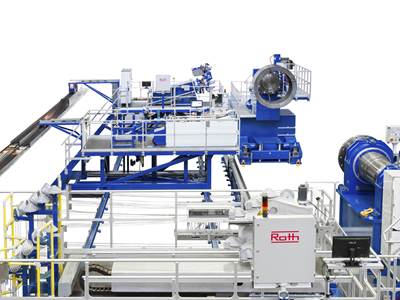Ariane 6 heavy-lift rocket makes inaugural launch
Carbon fiber launch vehicle powered into space in early July, demonstrating its ability to launch missions from low-Earth orbit and into deep space.
Ariane 6 launch. Source | European Space Agency (ESA)
A joint press release from the Ariane 6 Task Force — ESA, CNES, ArianeGroup and Arianespace — released on July 9th announced the inaugural flight of Ariane 6, a new heavy-lift rocket, from Europe’s Spaceport in French Guiana. It is the latest in Europe’s Ariane rocket series, featuring a modular and versatile design that can launch missions from low-Earth orbit and farther out into deep space. Speaking on its success, ESA’s director general Josef Aschbacher notes, “A completely new rocket is not launched often, and success is far from guaranteed.”
Ariane 6 was built by prime contractor and design authority ArianeGroup (Paris, France). At more than 60 meters tall, Ariane 6 weighs almost 900 tonnes when launched with a full payload. It comprises three stages — two or four boosters, and a main and upper stage. The rocket’s fairing (nose cone) is 5.4 meters in diameter and made of carbon fiber developed by Beyond Gravity (Zürich, Switzerland). A 2022 report says that Airbus (Toulouse, France) also provided four primary lightweight carbon fibers structures for the next 14 vehicle launchers, and FACC (Ried im Innkreis, Austria) was contracted in 2021 to to develop and manufacture the Astris kick stage main structure for the new launch vehicle family.
At 21:06 BST (4:06 CEST), one hour after liftoff, the first set of satellites on board Ariane 6 were released from the upper stage and placed into an orbit 600 kilometers above Earth. Satellites and experiments from various space agencies, companies, research institutes, universities and young professionals were included on this inaugural flight.
Artist's view of two Ariane 6 rockets in multiple configurations. Source | ESA - D. Ducros
The inaugural flight, designated VA262, was a demonstration flight whose aim was to show the capabilities and prowess of Ariane 6 in escaping Earth’s gravity and operating in space. In addition to the rocket, the liftoff demonstrated the functioning of the launch pad and operations on the ground at Europe’s Spaceport. The new custom-built launch zone was built by France’s space agency CNES and enables a faster turnover of Ariane launches.
“The next flight models [of Ariane 6] are already in production and the stages of the second model will be shipped to the Guiana Space Centre this autumn for the first commercial flight of Ariane 6,” says Martin Sion, CEO of ArianeGroup.
With the placement of satellites into orbit, Ariane 6 has demonstrated that it can successfully launch its payloads into space, but ground control has more in store for its inaugural flight. Ariane 6’s upper stage will prove again that it can restart its Vinci engine using its novel auxiliary propulsion unit. This restart capability will enable Ariane 6 to drop off multiple passengers into different orbits on future flights and de-orbit itself through Earth’s atmosphere at the end of its mission. On this flight, the Ariane 6 upper stage is set to release two reentry capsules as it enters Earth’s atmosphere for a clean disposal to burn up harmlessly, leaving no space debris in orbit.
The next Ariane 6 is planned for launch this year on its first commercial flight under Arianespace as operator and launch service provider. “The success of this first flight marks the start of Ariane 6’s operational career, giving Europe an autonomous access to space,” adds Stéphane Israël, CEO of Arianespace. “The new launcher’s order book is proof of the versatility of Ariane 6 and of its capacity to accomplish a wide range of missions into multiple orbits. We are eager to begin operating our new launcher.”
Related Content
Welding is not bonding
Discussion of the issues in our understanding of thermoplastic composite welded structures and certification of the latest materials and welding technologies for future airframes.
Read MoreComposites end markets: New space (2025)
Composite materials — with their unmatched strength-to-weight ratio, durability in extreme environments and design versatility — are at the heart of innovations in satellites, propulsion systems and lunar exploration vehicles, propelling the space economy toward a $1.8 trillion future.
Read MoreCarbon fiber, bionic design achieve peak performance in race-ready production vehicle
Porsche worked with Action Composites to design and manufacture an innovative carbon fiber safety cage option to lightweight one of its series race vehicles, built in a one-shot compression molding process.
Read MoreThe potential for thermoplastic composite nacelles
Collins Aerospace draws on global team, decades of experience to demonstrate large, curved AFP and welded structures for the next generation of aircraft.
Read MoreRead Next
Roth filament winder to facilitate major Ariane 6 weight/cost cuts
One of the world’s largest filament winding systems will soon begin manufacturing components for the Ariane 6 space launch vehicle, which is expected to transport satellites into Earth orbit for the European Space Agency (ESA) as early as 2020.
Read MoreUltrasonic welding for in-space manufacturing of CFRTP
Agile Ultrasonics and NASA trial robotic-compatible carbon fiber-reinforced thermoplastic ultrasonic welding technology for space structures.
Read More










